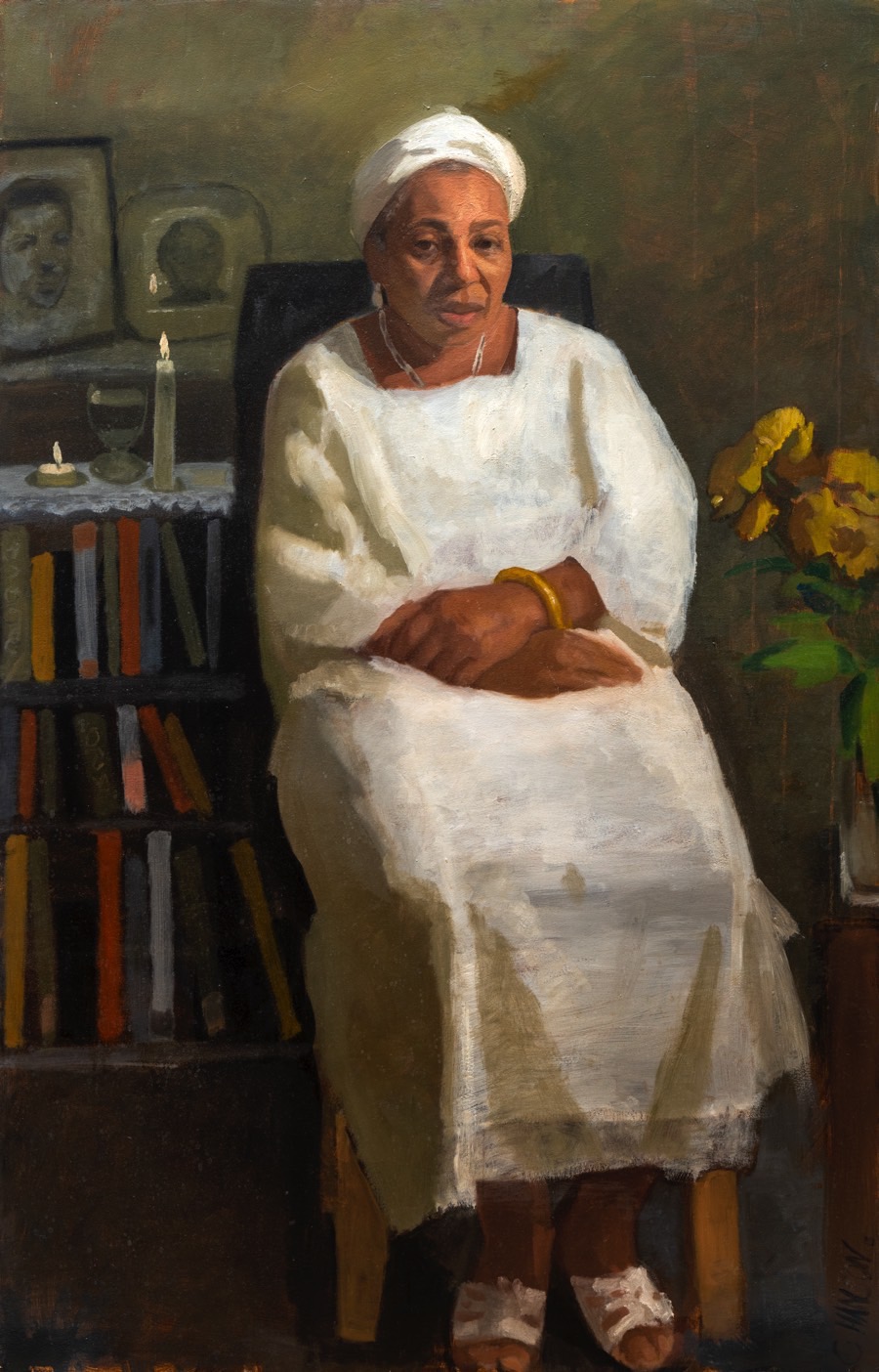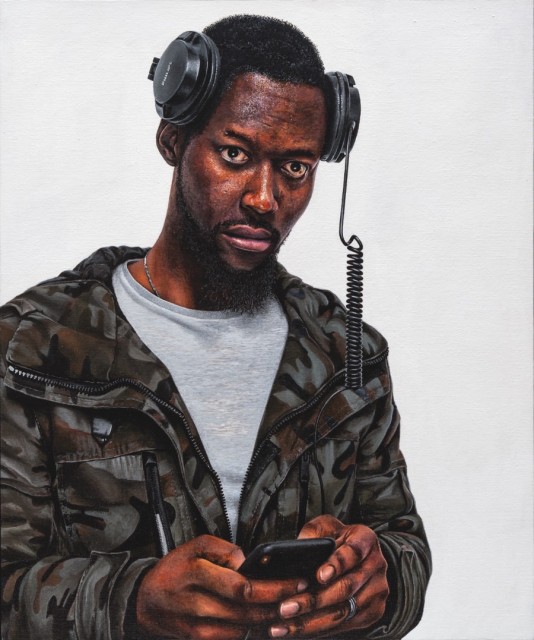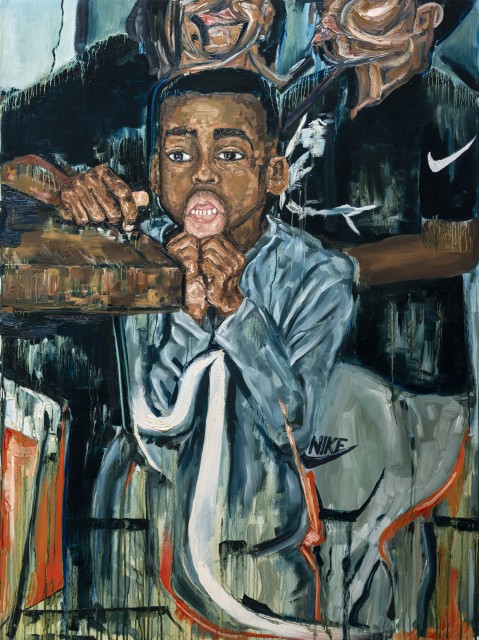John Moores Painting Prize 2020: Mothers and Sons

In a new series commissioned exclusively for us by the John Moores Painting Prize, playwright Marjorie H Morgan selects a trio of works that speak to Black life lived large from mother to son…
Wandering, virtually, through the works unified by the John Moores Painting Prize 2020 selection panel, I was particularly arrested by three paintings that formed a triptych in my mind’s eye: Mother (2018) by Christopher Hanson, Wetin dey (2019) by Peter Davis, and Likkle Man (2019) by Leah Michelle Cayol. Art is personal – both in its creation and consumption – and these pieces called out to me, as if using my name.
While these works are markedly different in content and painting style, for me they portray a generational community connection and way of being in the world. Hanson reminds me of my Mother and aunts, who I have seen sit quietly at the edge of reality; beneath their still exteriors is a never-ending series of racing thoughts and worries that belie their apparent tranquility. They are weathering internally – concerns about their sons’ futures are carved into their internal organs.
Davis makes me recollect all my male relatives who are so frequently caught in a stationary position between the competing actions of fight or flight; thus, asking the title question, Wetin dey, or, What is going on? Likewise, Cayol’s Likkle Man acts as a boomerang of hope, catching me in the immediacy of the joy and innocence of youth. There is nothing to tell me where the two sons are, but the behaviour of all three characters is universal without being rooted in any particular geography. These people inhabit worlds that are familiar – more like a village than a distant globe.


The three works are linked by the colour white; Hanson uses it to portray purity and stillness, while in Davis’ and Cayol’s work, whiteness produces a sense of restlessness. In Hanson’s Mother, where simplified shapes of images in the background are almost abstract, the life-sized central figure is clearly depicted and clothed in white. Davis’ Wetin dey is a hyperrealistic image of a young Black man in a camouflage jacket against a plain, off-white background. The compositional balance of the man foregrounding an undefined space brings greater strength to the detail in his motionless upper body. Cayol’s Likkle Man is full of the raw, unfettered movement of youth, while Hanson and Davis portray their characters as more contained and thoughtful. These depictions of the three ages of the Black body reached deeply into my psyche.
There is a sense of hesitancy in each of the three paintings. While triptychs were commonly the reserve of altarpieces, these works are to me a reflection on Black life lived large from mother to son. Hanson, Davis and Cayol have created masterpieces of expression and emotion: images that worship the Black body as they are caught in moments of hopeful quietness amid a world of chaos; where civil rights are not civil; where Black Lives Matter has existed as a cause since the exploitation of the Black body began centuries ago, with the international trade in human beings as chattel.
The artists’ interrogation of their subjects drew me in to pause alongside them, to see what and how they see. The paintings are an invitation to become a part of their worlds. As I wandered through the collection, I saw a welcome reminder of the simple, quiet joy of still moments, of love and a constant connection to home and a sense of belonging, usually offered unwaveringly by a mother, or by her presence alone.
Marjorie H Morgan is an award-winning playwright, director and producer based in Liverpool.
Peter Davis is a Manchester-based figurative painter, and a member of the Manchester Academy of Fine Arts (MAFA), the Contemporary British Portrait Painters (CBPP) and Castlefield Gallery Associates.
Christopher Hanson is a portrait and figurative painter who aims to capture not only the likeness but the essence of his sitters. His work has been selected for BP Portrait Award 2020, National Portrait Gallery, London, Ruth Borchard Self-Portrait Prize Exhibition, Piano Nobile, London 2019 and NAE Open, New Art Exchange Nottingham in 2019.
Leah Michelle Cayol is a figurative painter based in London. She explores how stories from photographs, particularly family albums, can be a collective memory for many, questioning societal boundaries surrounding identity.
This new text has been commissioned by the John Moores Painting Prize and is part of a creative-critical series published exclusively by The Double Negative during April and May. Writers were given free rein and approximately 500 words to respond to any painting or paintings from the 2020 exhibition, and in any style, tone or format that they wished to use.
The John Moores Painting Prize provides a platform for artists to inspire, disrupt and challenge the British painting art scene. Established in 1957, it is the UK’s longest running painting competition. For over 60 years the John Moores has brought to Liverpool the best contemporary painting from across the UK and has over that time, developed a legacy of supporting artists at all stages in their careers – undiscovered, emerging and established. All entries are judged anonymously. The John Moores 2020 jurors were: Hurvin Anderson, Alison Goldfrapp, Jennifer Higgie, Gu Wenda and Michelle Williams Gamaker.
See the exhibition yourself via their virtual tour!
Images, from top: Mother (2018) by Christopher Hanson, Wetin dey (2019) by Peter Davis, and Likkle Man (2019) by Leah Michelle Cayol





